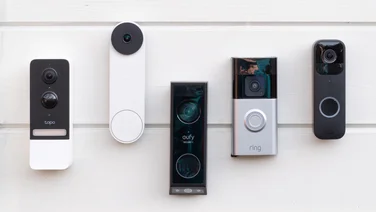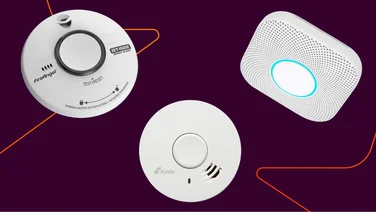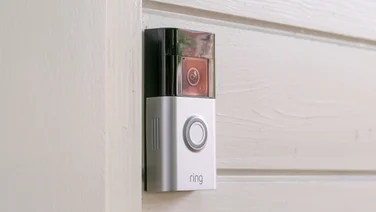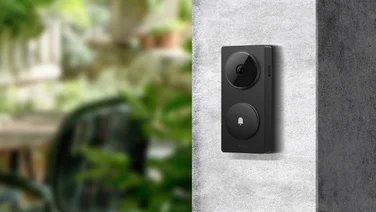To help us provide you with free impartial advice, we may earn a commission if you buy through links on our site. Learn more








- Built-in IoT hub
- Motorised 2K camera with tracking
- Supports 5GHz Wi-Fi
- Limited downward viewing angle
- Video is a little dull and colourless
- No siren or spotlight
Aqara may not be a household name in the UK, but the Chinese gadget maker has become one of the biggest global players in the Internet of Things market since it was founded in 2009. Today, it sells a wide range of connected sensors, switches, lights and locks in over 50 countries. If you want to make your house smart, the Aqara catalogue is as good a place to start as any other.
It’s the degree of IoT integration that separates the Aqara Hub G3 from the mass of internal security cameras because it can function as a fully-fledged IoT control hub, in addition to its core responsibilities. This makes it handy for someone who wants to start making their home smart, but doesn’t want to splash out on dedicated kit they may not fully utilise.
Opt for the Aqara Hub G3, and even if you only end up adding a few smart lightbulbs to your smart home system, you’ve still got a decent camera you can use to keep an eye on your home and pets.
What do you get for the money?
The Aqara Hub G3 is not the cheapest camera at £100, but you certainly do get a lot for your money. That starts with the design, which is a lot more distinctive than most rivals, and looks like an early design drawing for Eve from the Pixar film Wall-E, with a pair of cat ears stuck on for extra cuteness.
At 140mm tall to the tip of its ears, it’s not the smallest internal camera; indeed, it dwarfs the Blink Mini 2 cameras I have dotted around the house. It is a very solid unit, though. At the back of the unit, you’ll find a speaker grille and a USB-C port to connect the G3 to a power source. There is no battery.








The camera itself is a 2K affair with a maximum resolution of 2,304 x 1,296, with the capacity to shoot infrared when the lights go out. Detail levels are good, and the camera does a fine job of managing the exposure when pointed at a bright light source or a window. Because the lens isn’t a wide-angle affair, there’s no fisheye distortion at the edges of the frame.
Instead, the G3 can pan and tilt mechanically to take in the whole of your room, the latter by dint of the entire body rotating around the base plate, the former thanks to a gimbal mount that holds the camera lens and infrared sensor in the head section of the unit.
The various pan and tilt functions are controlled via a drop-down touchpad in the app menu, or you can drag a finger around the live video feed within the app. The former takes a calm hand to work smoothly; hold for too long, and the camera can overshoot. The Ring Pan Tilt responded more promptly to movement commands.








There is, however, a handy submenu in the drop-down app that lets you move the camera to one of five preset positions – and also a “cruise” option that sends the camera on a continuous sweep. The default is a full left-right sweep, but you can create your own sequences, too.
Put the G3 into sleep mode, and the camera fascia rolls back into the head to reveal the Micro SD card slot, which forms a mouth beneath a pair of sleeping eyes that allows you to save your recordings locally. The card slot can accept SD cards up to 128GB.
Beneath the camera fascia is a multi-function button surrounded by a multi-colour status LED. A three-second push of the button turns the G3 into an intercom, a ten-second push resets the network connection, while ten quick pushes gets you a factory reset. And there is a quarter-inch screw in the base so you can easily mount the entire assembly on a tripod or wall-bracket if you so wish.
Watching the body of the G3 swivel and the camera housing pan around it’s hard not to be impressed by the quality of the engineering with its smooth movements and quiet operation. The rotational action is effectively silent, and although there is a low hum to be heard when the camera mount moves up and down, it wasn’t loud enough to attract the interest of my dog.
How easy is it to set up?
The setup process was among the easiest I’ve encountered on a security camera. Just plug the camera in, download the Aqara Home app, then hold the QR code the app creates in front of the camera and enter your Wi-Fi password when prompted. Once you’ve entered your email address and password, you’re done. From opening the box to having the G3 working took less than five minutes.
Unlike some home cameras, the G3 is happy to connect to your home Wi-Fi network over either the 2.4GHz or 5GHz frequency bands, which is a boon if, like me, you run any 5GHz-only access points in your house.








Tailoring the app and camera to do exactly what you want can take a while, though, not because the Aqara Home app is any more complex or poorly structured than the equivalents from Ring, Tapo or Eufy, but because modern home security cameras are so feature-laden you have to drill down into the menu system to configure things just as you want.
The hardest part of the setup for me was finding the MicroSD card slot. Granted, there is a picture of the location on page 2 of the manual, which, of course, I hadn’t read, but it’s still not immediately clear that you can only access it in sleep mode when the camera is rolled back into the headpiece and the ‘sleeping eyes’ are visible.
What do we like about it?
There’s just no arguing with the G3’s comprehensive level of detection and notification. You can set the camera to detect general motion or limit detection to people and/or animals, as well as abnormal sounds. Sound detection can be adjusted to three levels of sensitivity, but you will quickly learn to set it to low unless you want to be alerted to the fact that your dog has got up for a quick stretch.
General motion detection can be further refined by setting zones of detection from a 6 x 4 grid and by adjusting levels of sensitivity. Push notifications can be enabled individually for each detection type, as can the period it operates in – and the frequency between events.








The Aqara Hub G3 also supports gesture and facial recognition. I was initially sceptical of the AI-enhanced system’s ability to match the image of my face I uploaded into the app with the sort of brief, odd-angle glimpse the camera was likely to get when I walked into a room, but the system worked with uncanny accuracy, never once triggering for anyone else.
The G3 can also recognise five pre-set hand gestures and can be set to only recognise gestures made by someone whose facial image is in the system. This is an “all or nothing” system, however. You can’t select which face can make gestures. If you are worried about accidentally triggering the gesture system, you can set it only to recognise gestures made with both hands.
Video recordings and snapshots can be stored locally, and you can add cloud storage if you subscribe to Aqara’s HomeGuardian service after the 14-day free trial that kicks off when you set the camera up.








According to Aqara, one benefit of cloud subscription is that it allows you to download and share video at resolutions above 360p, but I found that so long as I set the video recording quality to 1296p (2K) or 720p in the app, rather than the variable Fluent setting, then downloaded video held that resolution.
At the time of writing, a single camera subscription was $4.99 (£3.80) a month or $49.99 (£38) for a year, while a multi-camera account cost $9.99 (£7.60) a month and $99.99 (£76) a year.








In its role as a smart IoT home hub, the G3 excels. First up, the G3 works with Google Home, Alexa and Apple HomeKit – in particular, iCloud+ subscribers will benefit from HomeKit Secure Video storage (at the reduced resolution of 1080p) which allows iPhone users to store video clips in their iCloud.
That’s only half the story, though, because the G3 also contains a Zigbee 3.0 peer-to-peer IoT hub that can connect to up to 128 other Aqara devices, and it supports the Matter and IFTTT IoT standards as well.
In addition, it has an infrared wireless transceiver built in, so it can control any device that comes with an IR remote. As a very basic example of what you can do with the IR function, I set the Hub G3 up to recognise my face when I entered a room and then turn to face the IR transmitter towards my TV and switch it on, but only between the hours of 6pm and 10pm.
What could it do better?
The motorised camera action is, paradoxically, one of the weaker features of the G3, and it is a situation exacerbated by the camera’s 16:9 format.
While the physical horizontal rotation of 340 degrees and the basic viewing angle of 110 degrees across the diagonal give the camera the capacity to cover 360 degrees with overlap, the tilt mechanism is limited to 45 degrees, which restricts the vertical view.








To make matters worse, 30 degrees of that tilt is upwards, which means you can only decline the viewing angle by 15 degrees. That restricts the G3’s ability to look down from a high position. I’d prefer to have more down tilt than up, so I could place the camera higher up and still see the floor.
Given the size of the G3 camera unit, I’m not sure why it couldn’t have been engineered to give at least +30/-30 degrees of movement. As a design, then, it’s more limited than the Ring Pan Tilt, which can tilt through 169 degrees.
While the G3’s 2K camera is impressively sharp, it’s quite drab. Compared with the considerably cheaper and less feature-laden Blink Mini 2, it’s less bright and less colourful. The Blink also has an LED spotlight – another thing the Aqara lacks.








And despite having a loud and clear speaker, the G3 doesn’t have a siren, so there’s no quick way to startle burglars or misbehaving pets other than to start a call and yell “Oi, no!!”
Finally, when I ran our usual raft of timing tests the Hub G3 turned out not be as quick to react as the Ring Pan Tilt, and there was quite a degree of variance from one test to the next. In everyday use, though, the extra few seconds here and there isn’t worth getting too worked up about.
Should you buy it?
Suppose all you want is a basic camera that can look around a room. In that case, the Ring Pan Tilt is a cheaper alternative at just £70 and a better alternative because the camera has a wider range of vertical movement. However, the Ring camera is nothing like as feature-laden and lacks functions like facial recognition and tracking. And it doesn’t have the extensive HomeKit and Matter support the G3 has, either.
The killer feature of the Aqara is the comprehensive IoT hub, which means you can use it as the cornerstone of a project to make your home smart. If you’ve vaguely wondered about the benefits of a smart home but are yet to be convinced that turning on the lights yourself is such an unbearable chore, the Hub G3 is a good place to start.







